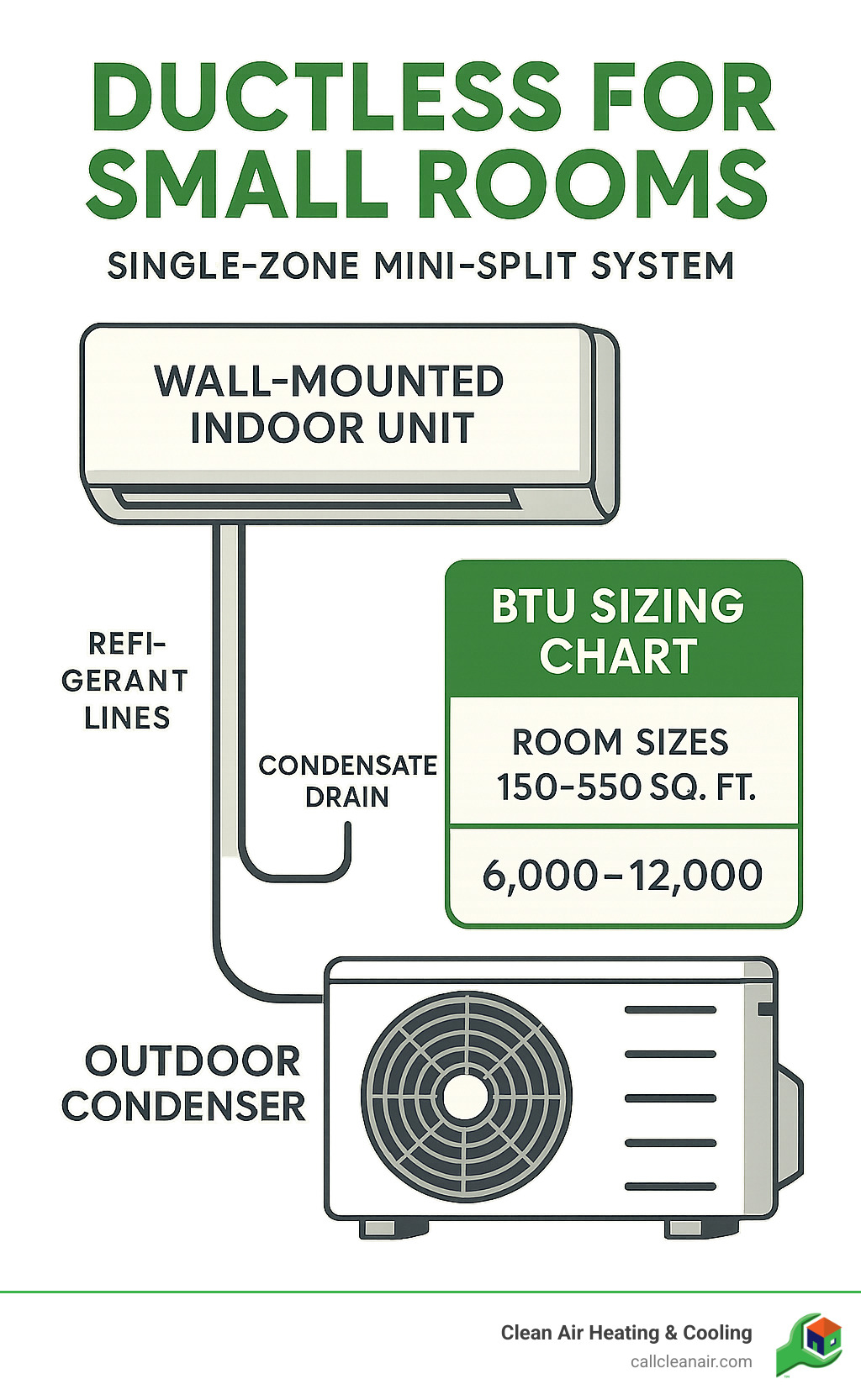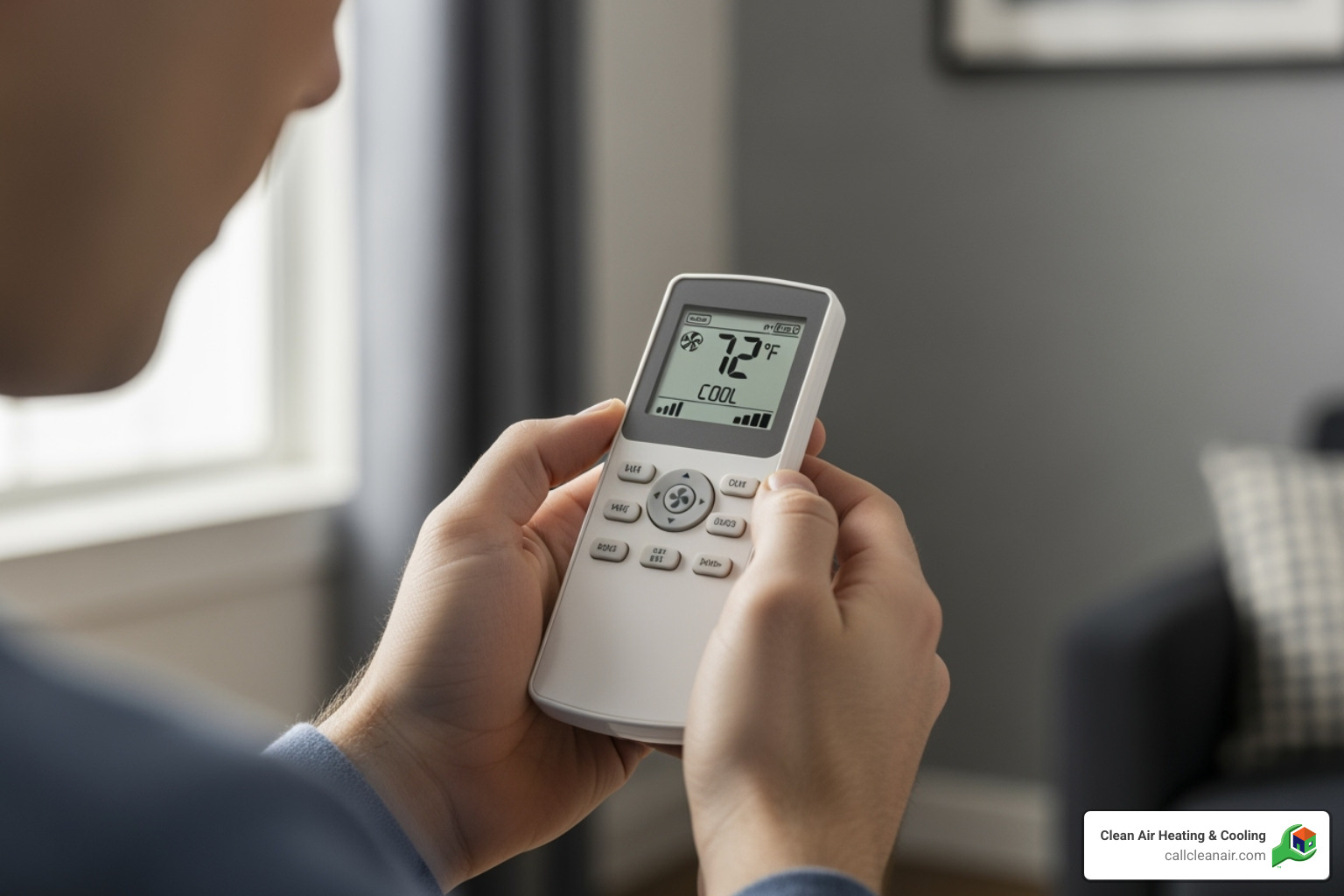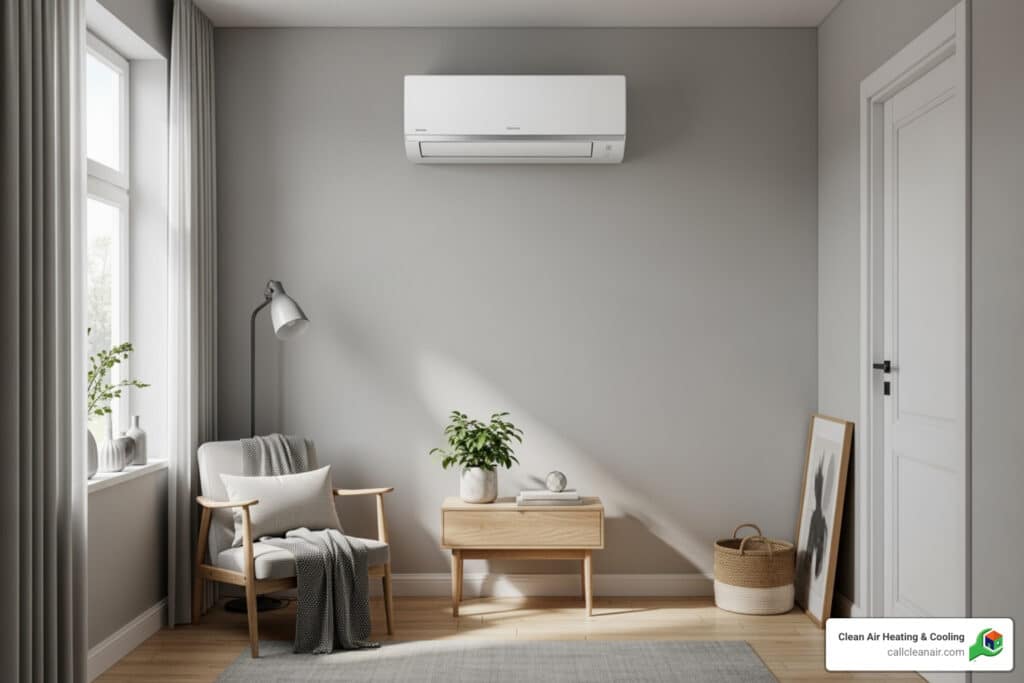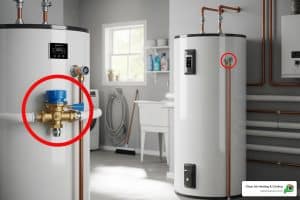Why Small Room Ductless Systems Transform Compact Living Spaces
Small room ductless systems offer the most efficient way to heat and cool individual rooms without the need for expensive ductwork installation. These compact, wall-mounted units provide precise temperature control, whisper-quiet operation, and significant energy savings compared to traditional heating and cooling methods.
Quick Answer for Small Room Ductless Systems:
- Best BTU Range: 6,000-12,000 BTUs for rooms 150-550 sq ft
- Energy Efficiency: SEER ratings of 15+ for optimal performance
- Installation: Professional mounting on interior walls with minimal home disruption
- Cost Savings: Up to 30% reduction in energy bills through zoned comfort
- Ideal Applications: Bedrooms, home offices, sunrooms, garage conversions, and room additions
Small rooms present unique comfort challenges. Traditional central air systems often leave compact spaces too hot in summer or too cold in winter. Window units are noisy and inefficient. Baseboard heaters create uneven temperatures and high electric bills.
A single-zone ductless mini-split solves these problems by delivering targeted comfort directly where you need it. These systems use advanced inverter technology to maintain consistent temperatures while using minimal energy. The indoor unit mounts quietly on your wall, while the outdoor condenser connects through a small hole – no major renovation required.
As Colin Matei, Owner and President of Clean Air Heating & Cooling in Bellingham, WA, I’ve helped hundreds of homeowners transform uncomfortable small spaces with small room ductless solutions. My experience shows these systems consistently deliver superior comfort and energy savings compared to traditional heating and cooling methods.

Why a Single-Zone Mini-Split is the Perfect Solution for Small Spaces
When we talk about single-zone mini-split systems, we’re referring to an HVAC setup designed to provide heating and cooling to a single, specific area or room. Unlike central HVAC systems that rely on extensive ductwork to distribute air throughout an entire home, a single-zone mini-split consists of one outdoor unit connected directly to one indoor unit. This direct connection makes them incredibly efficient and perfectly suited for compact spaces.
The benefits of choosing a single-zone mini-split for a small room are numerous:
- Zoned Comfort: This is a game-changer! Imagine being able to set the exact temperature you want in your bedroom, home office, or sunroom, without affecting the rest of your house. Single-zone systems allow for independent climate control, ensuring personalized comfort right where you need it most.
- Energy Efficiency: Because they only condition the space you’re using, small room ductless systems are inherently more energy-efficient. Traditional ducted systems can lose up to 30% of their energy through leaky ducts. Mini-splits eliminate this loss. Plus, many models feature inverter-controlled, variable-speed technology, which adjusts the motor speed to maintain consistent temperatures, much like cruise control in a car, saving even more energy.
- Quiet Operation: We often hear concerns about noisy HVAC systems. Mini-splits are renowned for their whisper-quiet operation. Indoor units typically run between 19 and 30 dBA, which is quieter than a whisper. This makes them ideal for bedrooms, nurseries, and home offices where silence is golden.
- Improved Air Quality: Without ductwork to collect dust, allergens, and debris, mini-splits contribute to cleaner indoor air. They circulate less dust and can be fitted with advanced filters, ensuring the air you breathe is fresher and healthier.
- Flexible Installation: The “ductless” part means just that – no ducts! This allows for incredible flexibility in placement. Indoor units can be wall-mounted, ceiling-cassette, floor-console, or even concealed. This makes them perfect for older homes, additions, or spaces where traditional ductwork is impractical or impossible.
To truly understand the magic behind these systems, it helps to know how they work. We’ve put together a comprehensive guide on How Do Ductless Mini Split Systems Work? that explains the process from refrigerant flow to heat transfer.
Ideal Applications for a Ductless System
When we consider the versatility and efficiency of single-zone mini-splits, a clear list of ideal applications emerges. These systems are truly perfect for:
- Home Offices: Creating a comfortable and productive workspace, free from the distractions of an overly hot or cold room.
- Bedrooms: Ensuring a perfect sleeping environment, allowing you to drift off in quiet comfort without cooling or heating unused parts of the house.
- Sunrooms: These spaces often suffer from extreme temperature swings. A ductless unit can provide year-round comfort, making your sunroom an enjoyable retreat regardless of the season.
- Garage Conversions: Changing a cold, dusty garage into a livable space, like a home gym, workshop, or extra bedroom, requires dedicated climate control. A small room ductless system is the ideal solution.
- Basements: Basements can be notoriously damp and chilly. A mini-split can effectively condition these spaces, making them more inviting and usable.
- Room Additions: When you expand your home, extending existing ductwork can be costly and disruptive. A single-zone mini-split is a straightforward, efficient way to heat and cool your new space.
- Problem Areas: Do you have a room that’s always too hot or too cold, no matter what you do? A mini-split can target these “problem areas” and balance out your home’s temperatures.
These systems are available in various capacities and designs to control environmental conditions for residential and even light commercial applications, making them incredibly adaptable.
Ductless Mini-Splits vs. Traditional HVAC for Small Rooms
Let’s face it, we all want efficient and effective heating and cooling. But how do small room ductless systems stack up against the traditional HVAC methods we’re used to? The comparison highlights why mini-splits are often the superior choice for compact spaces.
- No Ductwork Needed: This is perhaps the most significant difference. Traditional central air systems rely on a network of ducts to distribute air. Installing or extending this ductwork can be a massive undertaking, especially in older homes or new additions where retrofitting is challenging and costly. Ductless systems bypass this entirely, requiring only a small conduit to connect the indoor and outdoor units.
- Lower Energy Loss: With traditional ducted systems, a considerable amount of conditioned air can escape through leaks, gaps, or poorly insulated ducts. Some estimates suggest up to 30% of energy can be lost this way! Ductless systems deliver conditioned air directly into the room, virtually eliminating this energy waste. This means more of your energy dollar goes directly to cooling or heating your space.
- Precise Temperature Control: Central HVAC systems typically treat your entire home as one zone, leading to a “one size fits all” temperature setting. This often results in some rooms being too hot and others too cold. Mini-splits, with their zoned control, allow you to set specific temperatures for individual rooms. This level of precision is simply best by traditional setups.
- Advantages over Central Air: Beyond energy loss and zoned control, mini-splits offer easier installation for specific areas, quieter operation, and improved indoor air quality due to the absence of dust-collecting ducts. They are perfect for homes without existing ductwork or for supplementing a central system that struggles with certain areas.
- Advantages over Older Heating and Cooling Methods: Compared to window AC units, mini-splits are far more efficient, quieter, more secure (no open window), and offer both heating and cooling. Compared to baseboard heaters or portable electric heaters, mini-splits provide more even heating, are significantly more energy-efficient, and offer cooling capabilities. They are a modern, comprehensive solution for year-round comfort.
Choosing the Right Small Room Ductless System
Finding the perfect small room ductless system for your space doesn’t have to feel overwhelming. Think of it like shopping for a new car – you want something that fits your needs, runs efficiently, and gives you the best value for your money. The key is getting the sizing right, understanding what those efficiency numbers actually mean, and knowing which features matter most for your specific situation.

The most important decision you’ll make is getting the sizing right. Too small, and your unit will work overtime trying to keep up. Too big, and it’ll cycle on and off constantly, wasting energy and leaving you with uneven temperatures. It’s like Goldilocks – you want it just right.
You’ll also want to pay attention to energy ratings like SEER and HSPF. These aren’t just random numbers – they directly impact how much you’ll spend on electricity each month. Higher ratings mean lower bills, which is always a win in our book.
Don’t forget about the practical stuff either. Most small room ductless units come in either 115V or 230V options. Your electrician can help determine which voltage works best for your home’s electrical setup. Some key features to consider include programmable timers, wireless remote controls, and advanced filtration systems that keep your air clean and fresh.
Sizing Your Small Room Ductless Unit: BTUs and Square Footage
Here’s where the rubber meets the road – getting your BTU calculation right. BTU stands for British Thermal Unit, and it’s simply a way to measure how much heating or cooling power your unit provides. Think of it as the horsepower of your climate control system.
The magic number most pros use is 20 BTUs per square foot, but your specific needs might vary. A 6,000 BTU unit works beautifully for cozy spaces around 150-250 square feet – perfect for a guest bedroom or small home office. Step up to 9,000 BTUs, and you can comfortably handle 250-400 square feet, which covers most standard bedrooms and medium-sized workspaces. For larger areas up to 550 square feet, a 12,000 BTU system is your best bet.
But square footage is just the starting point. Ceiling height makes a big difference – those beautiful vaulted ceilings might look great, but they create more space to heat and cool. Insulation quality is another game-changer. Well-insulated rooms hold their temperature like a good thermos, while poorly insulated spaces leak energy like a sieve.
Window exposure can really throw a wrench in your calculations too. A room with big south-facing windows turns into a greenhouse in summer, needing extra cooling power. Even the number of people regularly using the space matters – we all generate heat, and that adds up.
For the complete breakdown on sizing your system perfectly, check out our detailed guide: What Size Mini Split Do I Need?
Understanding Efficiency Ratings: SEER, EER, and HSPF
Let’s decode those efficiency ratings that seem designed to confuse everyone. SEER (Seasonal Energy Efficiency Ratio) is your go-to number for cooling efficiency. It measures how much cooling your system delivers compared to how much electricity it uses over an entire season. Higher SEER means lower electric bills – it’s that simple.
The government recently updated testing standards to SEER2, which gives you a more realistic picture of real-world performance. We recommend looking for systems with SEER ratings of 15 or higher for optimal performance and savings.
HSPF (Heating Seasonal Performance Factor) does the same thing for heating efficiency. Since most small room ductless systems are heat pumps that provide both heating and cooling, this number tells you how efficiently they’ll keep you warm during chilly Pacific Northwest winters.
EER (Energy Efficiency Ratio) measures efficiency at peak conditions – basically how well your system performs when it’s working hardest on those scorching summer days.
Here’s a pro tip: look for ENERGY STAR-certified systems. These units meet strict efficiency guidelines and are proven money-savers. High-efficiency systems with inverter technology don’t just save energy – they provide more consistent comfort by avoiding the constant on-off cycling that makes cheaper units so annoying.
Want to dive deeper into cooling efficiency? Our Mini Split Cooling Efficiency page has all the details.
Potential Drawbacks of a Small Room Ductless System
We love small room ductless systems, but we believe in giving you the whole picture. Like any home improvement, these systems come with a few considerations worth thinking about upfront.
The upfront cost is typically higher than slapping a window unit in place or plugging in a space heater. However, the energy savings usually pay for this difference over time – think of it as an investment in your comfort and lower utility bills.
Some folks worry about the aesthetics of the indoor unit. The wall-mounted unit is visible in your room, though modern designs are much sleeker than older models. If the look really bothers you, there are ceiling cassette and concealed options that practically disappear.
Regular filter maintenance is a must – plan on cleaning filters about once a month during heavy use seasons. The good news? It’s easier than changing your car’s oil and takes just a few minutes.
Finding a qualified installer is crucial for proper performance and warranty coverage. While some DIY options exist, most systems need professional installation to handle refrigerant lines, electrical connections, and proper sizing. This isn’t a job for your weekend warrior neighbor – you want a certified HVAC technician.
Curious about installation costs? We break down everything you need to know on our How Much Does It Cost to Install a Mini Split? page.
Installation and Maintenance in Compact Areas
The beauty of small room ductless systems lies not only in their efficiency but also in their relatively straightforward installation process compared to traditional ducted systems. However, “straightforward” doesn’t necessarily mean it’s a weekend DIY project for everyone.

While some handy homeowners might consider tackling the installation themselves, especially with pre-charged line sets, we almost always recommend professional installation. Here’s why: a qualified HVAC technician ensures proper sizing, correct refrigerant line connections, proper electrical wiring, and the crucial step of vacuuming the lines to remove air and moisture. This attention to detail guarantees optimal performance and longevity – plus, it keeps your warranty intact.
When planning installation in a compact area, placement becomes especially important. The indoor unit placement typically involves wall-mounting near the center of the room, away from obstructions that might block airflow. For those who prefer a more discreet look, ceiling cassette models install flush with the ceiling, practically disappearing into your décor.
Outdoor unit placement requires a stable, level surface with adequate clearance for airflow. The condenser should be protected from direct sunlight and positioned where its operational sound won’t disturb anyone (though modern units are impressively quiet). The magic happens through a small hole drilled through your exterior wall, connecting the refrigerant lines and electrical wiring between indoor and outdoor units.
Don’t forget about the condensate drain line. During cooling, your indoor unit produces condensation that needs somewhere to go. A properly sloped and insulated drain line channels this water safely outside, preventing blockages or freezing issues that could cause headaches later.
For a detailed walkthrough of what to expect during installation, check out our comprehensive Mini Split AC Installation guide.
Simple Maintenance for Lasting Performance
Here’s some great news: small room ductless systems are remarkably easy to maintain. A little regular attention from you, combined with occasional professional tune-ups, will keep your system running efficiently for 15-20 years or more.
Filter cleaning tops the maintenance priority list. Those air filters in your indoor unit should be cleaned about once a month – more often if you have pets or family members with allergies. Clean filters mean better airflow, improved energy efficiency, and cleaner air for your family. It’s a simple task that makes a huge difference. Our detailed guide on Cleaning Mini Split Heat Pump walks you through the process step by step.
Your outdoor unit inspection doesn’t require any special skills – just keep an eye on it. Make sure leaves, grass clippings, or other debris aren’t blocking the airflow. A quick visual check every few weeks, especially during fall when leaves are dropping, keeps everything running smoothly.
Professional tune-ups are where we come in. We recommend scheduling an annual maintenance visit where our technicians clean both indoor and outdoor coils, check refrigerant levels, inspect electrical connections, ensure the condensate drain line flows freely, and assess overall system performance. Think of it as a physical for your mini-split – catching small issues before they become expensive problems.
Checking for leaks is something you can easily do yourself. Keep an eye out for unusual moisture around the indoor unit or along the condensate drain line. Catching leaks early prevents water damage and keeps your system running at peak efficiency.
This consistent maintenance approach open ups the full lifespan and energy-saving potential of your investment. Curious about exactly how long these systems can serve your home? Our page on How Long Do Mini Split Systems Last? has all the details you need.
Frequently Asked Questions about Ductless Systems
We get lots of questions about small room ductless systems, and honestly, we love talking about them! These three questions come up in almost every conversation we have with homeowners who are considering making the switch.
How much can I save on energy bills with a ductless system?
This is probably the question we hear most often, and for good reason – the savings can be pretty impressive! Most homeowners see up to 30% savings on their energy bills after installing a ductless system. That’s real money back in your pocket every month.
Here’s why the savings are so significant. Traditional ducted systems lose a shocking amount of energy through leaky ducts. We’re talking about eliminating duct loss that can waste up to 30% of your conditioned air before it even reaches your room. With a small room ductless system, all that energy goes directly into making your space comfortable.
The zoned usage benefits are where things get really exciting. Let’s say you’re working from home in your office – you can keep that room at the perfect temperature while letting the rest of the house coast at a more energy-efficient setting. You’re only paying to condition the space you’re actually using, which makes a huge difference on your monthly bills.
The Department of Energy backs up these savings claims, noting that ductless systems are among the most energy-efficient heating and cooling options available for individual rooms.
Do ductless systems provide both heating and cooling?
Absolutely! This might be one of the best-kept secrets about modern small room ductless systems. Most units today are actually heat pumps, which means they’re like having two systems in one.
Heat pump technology is pretty clever. In summer, your unit moves heat from inside your room to the outside. When winter comes, it reverses the process and pulls heat from the outdoor air (yes, even when it’s cold outside!) and brings it into your room. It’s the same unit doing both jobs.
This means you get year-round comfort from a single installation. No need for separate heating and cooling systems, no switching between different equipment with the seasons. Your ductless unit handles it all with the touch of a button on your remote.
In our Pacific Northwest climate, these systems work beautifully as a primary heat source for most of the year. During those rare extremely cold snaps, they can serve as excellent supplemental heat alongside your existing heating system. Modern units with advanced technology can actually provide reliable heating even when outdoor temperatures drop to -13°F.
Want to know more about installation costs for heat pump systems? Check out our detailed breakdown on Mini Split Heat Pump Installation Cost.
How quiet are ductless mini-splits?
If you’ve ever been kept awake by a noisy window air conditioner or been distracted by the whoosh of forced air through vents, you’ll love this answer. Small room ductless systems are remarkably quiet – we’re talking whisper-quiet operation that you’ll barely notice.
Most indoor units operate between 19 and 30 decibels (dBA). To put that in perspective, normal breathing is about 10 dBA, a whisper is 20 dBA, and a quiet library is around 30 dBA. Your ductless system will be right in that sweet spot where it’s practically silent.
The outdoor unit is typically a bit louder than the indoor unit, but it’s still much quieter than traditional central air condensers. Plus, since it’s outside, the sound rarely becomes an issue indoors.
This quiet operation makes ductless systems ideal for bedrooms and offices where concentration and rest are priorities. You can sleep soundly, work without distraction, and enjoy peaceful conversations without competing with HVAC noise. It’s one of those features that once you experience it, you’ll wonder how you ever lived with noisy heating and cooling systems!
Maximize Your Comfort with a Professional Ductless Installation
After reading through all the benefits and technical details, you might be feeling excited about the possibilities a small room ductless system could bring to your home. And honestly, you should be! These systems offer something pretty special: targeted comfort that works exactly where and when you need it.
Think about it – no more suffering through sweltering summer afternoons in your home office or shivering through cold winter mornings in that spare bedroom. Instead, you get precise temperature control that adapts to your lifestyle, not the other way around.
The energy savings alone make these systems worth considering. When you’re only heating or cooling the spaces you’re actually using, your utility bills start to reflect that efficiency. Many of our customers are amazed when they see their first energy bill after installation – it’s like getting a monthly reminder of how smart their investment was.
But here’s what really matters: the long-term value. A quality small room ductless system isn’t just about immediate comfort. It’s about years of reliable, efficient operation that keeps paying you back through lower energy costs and consistent performance.
At Clean Air Heating & Cooling, we’ve seen how these systems transform people’s daily lives. Based right here in Bellingham, WA, we serve homeowners throughout Whatcom, Skagit, Snohomish, and San Juan Counties. Our team specializes in heating, cooling, and air quality services, and we’ve become pretty passionate about helping people find the comfort that ductless systems provide.
We’re proud of our track record – over 480 five-star Google reviews from neighbors just like you, plus our 25% utility savings guarantee that backs up everything we’ve talked about in this guide. When we say we’re committed to your satisfaction, we mean it.
If you’re ready to transform that uncomfortable small room into a perfectly climate-controlled space, we’d love to help you explore your options. A professional consultation can help you determine the ideal system size, placement, and features for your specific situation.
Don’t let another season go by dealing with uncomfortable temperatures in your small spaces. Let’s work together to create the comfort you deserve. Learn more about our comprehensive Ductless Mini Split Systems and find how we can help you breathe easier and live more comfortably.





